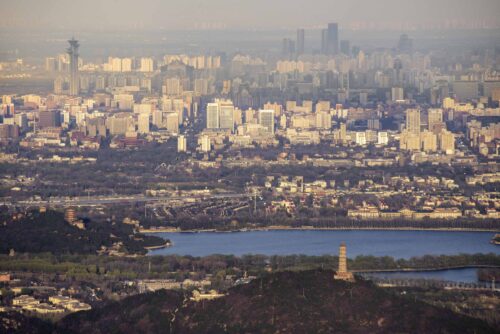Inside China’s ambitious plan to create its first national park system
Inside China’s ambitious plan to create its first national park system

When Zhu Ziyun 朱子云 first set foot in the area of Sanjiangyuan 三江源, he was taken aback by the natural beauty that unfolded before him. It was July 2011, a fierce summer month for those on the Tibetan Plateau in Qinghai Province, and Zhu, then a junior studying bioscience at Peking University, experienced mixed feelings of trepidation and excitement. Born and raised in a metropolitan environment, Zhu had never been to a place where cell phone reception was a luxury, power failure was the norm, and the best hotel in the region lacked private showers. But as an aspiring bioscientist eager to explore nature, he was amazed by how unspoiled Sanjiangyuan remained while urbanization swept across the rest of the country.
Sanjiangyuan’s lack of blemish has ensued from its isolation. Resting on a high-altitude plateau exceeding 3,000 meters (9,800 feet) on average, the region is geographically unfriendly to city dwellers, who prefer taking less arduous tours of Jiuzhaigou in Sichuan Province or Lijiang, Yunnan Province. Culturally, Sanjiangyuan covers a vast area of about 140,000 square miles, comprising 43 percent of Qinghai Province, and is home to about 600,000 people, 90 percent of whom are Tibetan nomads who herd livestock and sleep in tents. While Sanjiangyuan has always been adored by nature lovers like Zhu, it was largely unknown to the population at large.
But that changed in 2015, when the central government announced an initiative to set aside a vast area of wetlands and grasslands in Sanjiangyuan for the country’s first national park. In 2016, President Xi Jinping 习近平 visited Qinghai to emphasize the essential role that Sanjiangyuan would be expected to play. Praising Sanjiangyuan as “the country’s origin of life,” Xi demanded better protection of the area, given its strategic position in safeguarding a much larger ecosystem, as it contains the headwaters of three major Asian rivers — the Yellow, the Yangtze, and the Mekong. “Practice has proved that restricting or forbidding development in the Sanjiangyuan area is not a hurdle to its growth,” Xi said, surrounded by a group of local officials. “In fact, quite the opposite. It is beneficial.”
With Sanjiangyuan taking the lead, eight other regions (in Chinese) — Beijing and the provinces of Jilin, Heilongjiang, Zhejiang, Fujian, Hubei, Hunan, and Yunnan — have been selected to carry out pilot projects that together would constitute a national park system, the first of its kind in Chinese history.
It should be noted that China already has a handful of natural sites that bear the name “national park,” such as Tangwang River National Park 汤旺河国家公园 in Heilongjiang, Laojun Mountain National Park 老君山国家公园 in Lijiang, and Aer Mountain National Park 阿尔山国家公园 in Inner Mongolia, just to name a few. These areas, however, “are less national parks than tourist attractions,” said Zhu, who has been to most of them for research purposes. “They were built with good intentions, but over the years, local governments exploited them to attract tourists, putting economic interests above environmental protection goals.” Asked why these self-proclaimed “national parks” fell victim to commercialization, Zhu replied, “Too many factors are in play. There are administrative problems. Lack of qualified personnel. Insufficient funding. And above all, the understanding of the concept of ‘national park’ was fundamentally wrong.”
These challenges, according to the U.S.-based think tank Paulson Institute, which has partnered with China’s National Development and Reform Commission (NDRC) to enact the plan, are what the new national park system aims to solve. They have studied successful models in Western countries, especially in the United States. But how much of the U.S. model can be transplanted into the Chinese context? What are the potential obstacles? And after all is said and done, will China fulfill its goal to have its first national park system by 2020?
American idea, Chinese implementation

In 1872, after years of expedition efforts led by naturalists and geologists, President Ulysses S. Grant signed an act in 1872 that officially granted permission to construct Yellowstone National Park, the first national park in the world. The law also explicitly stated that Yellowstone was to be a designated natural site “for the benefit and enjoyment of the people,” with “all timber, mineral deposits, natural curiosities, or wonders” within it to be retained “in their natural condition,” though roads, bridle paths, and buildings for the accommodation of visitors were permitted.
In the years that ensued, the U.S. continued to carve out land for conservation. By the time President Theodore Roosevelt left the White House in 1909, there were eight national parks in the U.S., and the network was expanding. The American West in the late 19th century saw a flood of visitors arrive from all over the world. Enchanted by all the stunning attractions that the U.S. had to offer, these outsiders brought the idea of national parks back to their countries. As a result, Australia had its first national park in 1879, followed by New Zealand in 1894, and Sweden in 1909.
By the end of 2010, China had 2,541 nature reserves, 208 national scenic areas, and 660 national forest parks, yet none of them qualified as a national park by international standards.
China, meanwhile, created its first natural reserve in Guangzhou Province in 1925. The founding of the Dinghu Mountain National Nature Reserve was largely inspired by the Soviet Union, which for the most part used natural reserves for scientific research and prohibited any human activity in the region. Given the ideological affinity between the two countries in the 1920s, it’s no surprise that China wanted to copy the Soviet model, but the stark difference in their landscapes posed some unique challenges: China, a densely populated country, had a shortage of deserted land with which it could seal off from humans.
Still, that didn’t stop China from rushing to establish nature reserves of all kinds beginning in the 1990s, hoping to win global recognition for its efforts in environmental protection. Meanwhile, at a provincial level, governments exploited these protected areas for economic benefits and political rewards. It was during this period that many protected — though barely visited — areas were given the “national park” label, as officials hoped this could attract more tourists.

By the end of 2010, China had 2,541 nature reserves, 208 national scenic areas, and 660 national forest parks, yet none of them qualified as a national park by international standards. While definitions might vary from country to country, the International Union for Conservation of Nature defines a national park as “large natural or near natural areas set aside to protect large-scale ecological processes…which also provide a foundation for environmentally and culturally compatible spiritual, scientific, educational, recreational and visitor opportunities.” The group estimates there are more than 6,500 national parks worldwide.
How many obstacles to overcome?
Despite its acclaim, Yellowstone’s early years were not without setbacks. Locals feared that the regional economy would suffer due to strict federal prohibitions against development or settlement within park boundaries. Local entrepreneurs called for the reduction of the park’s size so that mining, hunting, and other activities could be developed. The federal government had no involvement until 1877, when Congress decided to expand access to the park and help build crude roads and facilities. And it was not until 1916 that the National Park Service was established as the first agency of the United States federal government to manage all national parks (plus national monuments and other conservation and historical properties).
As the U.S. perfected its model, a host of challenges were addressed along the way. China, no doubt, will face those same obstacles. From an administrative perspective, a long-standing problem has been the enforcement of rules protecting restricted areas, in part because there are too many regulating bodies. Currently, 13 different government agencies have a stake in overseeing protected areas, which creates, in Zhu’s words, “the problem of nine dragons managing the water” (九龙治水 jiǔlóng zhìshuǐ). The Paulson Institute also agrees that the “invention of a highly effective governance system is the priority of the new system.”
While the national park system is designed to play a massive role in protecting the country’s biodiversity, it alone is far from enough to help China realize its long-term commitment to ecological conservation.
Another huge challenge is how to thoughtfully define the mission of the national park system and its relationship with existing protected areas. National parks should enhance the “protected area” designation, rather than weaken the status of other sites with that label. “In the Western hemisphere, ‘national park’ is a mature concept that leaves little room for personal or creative interpretations,” Zhu said. “But in China, the concept is still a novelty. Without a strict definition coming from the top, local officials tend to interpret the idea in a way that serves them best.” Zhu gave the example of the word park (公园 gōngyuán), which “inherently means a place for recreation in the Chinese language. So for those who want to use national parks to attract tourists, they might tap into this.”
Only after these two fundamental obstacles, one administrative and one conceptual, are overcome can China’s national park system have a solid foundation with which to tackle other challenges. They include how to solve land disputes, how to balance economic development with nature conservation, how to hire and train professional and qualified personnel to manage the parks, how to institute oversight, etc. And perhaps more importantly, how to incentivize local governments and convince them the effort is worth it.
Conservation beyond

As part of the United Nations Convention on Biological Diversity (CBD), China is committed to setting aside at least 17 percent of its land resources for preservation by 2020. If measured by numbers alone, the goal seems attainable, given that China’s thousands of conservation areas already comprise 15 percent of the country, with China vowing to designate more in the next few years. However, many experts are concerned about the striking imbalance between the number of protected areas in the eastern and western parts of the country.
“There are many ultra-large natural reserves cluttered in western China,” said Zhu. Among them is Sanjiangyuan National Nature Reserve in Qinghai, currently the largest such area in the country. “But in eastern China, where a delicate balance between humans and nature is hard to achieve due to the high level of industrialization and the relatively high population density, protected areas are rare.”
And while the national park system is designed to play a massive role in protecting the country’s biodiversity, it alone is far from enough to help China realize its long-term commitment to ecological conservation. What’s still missing are solutions to environmental issues that extend beyond the geographical boundaries of protected areas. According to the Paulson Institute, China also needs better land use planning at different levels and a variety of well-planned and targeted environmental protection programs to “safeguard and maximize the benefits provided by protected areas to both nature and people.”
“The idea of a national park system has been fully realized in many countries. But for China, it’s brand new,” said Zhu, adding that his attitude toward the reform can be summed up as both optimistic and pessimistic. “Sure, we have a handful of problems to solve, and sure, we don’t have any prior experience in doing this. But the fact that this is a concept-in-progress has already unlocked a world of possibilities.”









